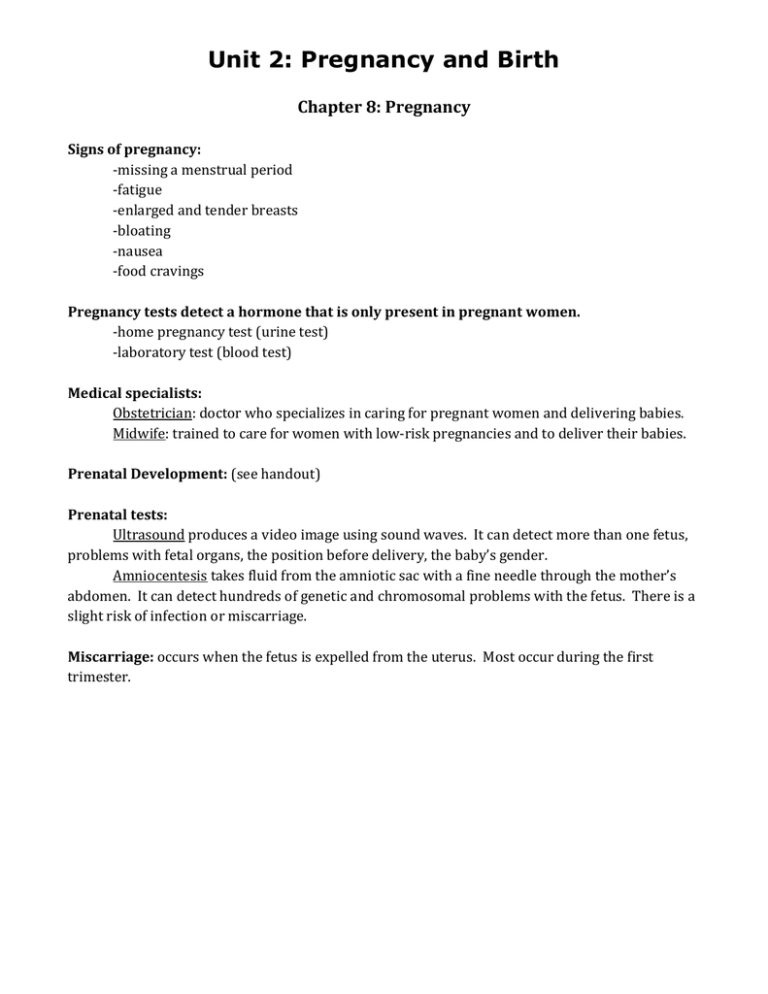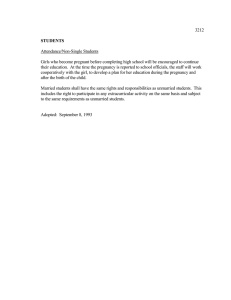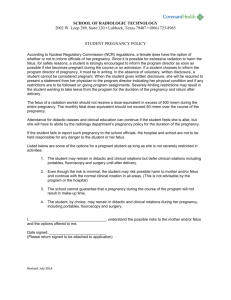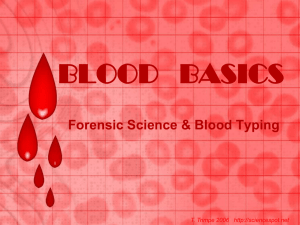Unit 2: Pregnancy and Birth Chapter 8: Pregnancy
advertisement

Unit 2: Pregnancy and Birth Chapter 8: Pregnancy Signs of pregnancy: -missing a menstrual period -fatigue -enlarged and tender breasts -bloating -nausea -food cravings Pregnancy tests detect a hormone that is only present in pregnant women. -home pregnancy test (urine test) -laboratory test (blood test) Medical specialists: Obstetrician: doctor who specializes in caring for pregnant women and delivering babies. Midwife: trained to care for women with low-risk pregnancies and to deliver their babies. Prenatal Development: (see handout) Prenatal tests: Ultrasound produces a video image using sound waves. It can detect more than one fetus, problems with fetal organs, the position before delivery, the baby’s gender. Amniocentesis takes fluid from the amniotic sac with a fine needle through the mother’s abdomen. It can detect hundreds of genetic and chromosomal problems with the fetus. There is a slight risk of infection or miscarriage. Miscarriage: occurs when the fetus is expelled from the uterus. Most occur during the first trimester. Unit 2: Pregnancy and Birth Chapter 9: Prenatal Care Eating Right: Women should seek a balanced diet, choosing a variety of foods, and following Canada’s Food Guide for Healthy Eating. This includes -7-8 servings of fruit and vegetables -6-7 servings of grain products -2 servings of milk products -2 servings of meat or alternatives - 2-3 tbsp of healthy oils each day Pregnant women should add 2-3 extra servings from any category. Protein: -found in meat, poultry, fish, eggs, beans and milk. -helps build the brain, muscles, hair, skin, nails, and immune system. Carbohydrates: -complex carbohydrates are found in whole grains, cereals, pastas, peas, beans, nuts, seeds, whole grain breads, rice, and potatoes. Fats: -fats are important for good health and energy. They allow the body to use vitamins A, D, E, and K. Vitamins: Folic Acid: helps produce extra blood, helps prevent birth defects of the nervous system. Found in broccoli, green leafy vegetables, and orange juice. B Vitamins: important for nerve cells and formation of red blood cells. Found in meat, grains and milk products. Vitamin A: helps develop cells, bones, vision. Too much can cause birth defects. Found in milk products, fruit and vegetables that are orange, dark green and deep yellow. Vitamin C: helps produce collagen which gives structure to bones, muscles and blood vessels. Helps the body absorb iron. Found in orange juice, melon, tomatoes and green peppers. Vitamin D: helps develop bones and tissue. Found in milk, egg yolks, and sunlight. Minerals: Calcium: helps build strong bones and teeth. Found in milk, yogurt, broccoli. Iron: pregnant women need two times more iron than usual. Iron is used to create blood supply to the fetus. Found in dried fruit, organ meats and leafy green vegetables.\ Unit 2: Pregnancy and Birth Water: drink at least 8 glasses of water, juice and other liquids each day. Weight Gain: most doctors recommend that women gain 10-15 kg (25-30 lbs) during their pregnancy. Typical weight gain: Baby 3.5 kg (7.5 lbs) Placenta 5 kg (1.5 lbs) Amniotic Fluid 1 kg (2 lbs) Uterine enlargement 1kg (2 lbs) Breast Growth 1 kg (2 lbs) Fluids and Blood 4 kg (8 lbs) Fat and nutrient stores 3 kg (7 lbs) Exercise: is important during pregnancy. Helps boost energy level. Helps physical discomforts like backache, constipation, heartburn, swollen ankles. Excessive exercise can cause more harm than good. Talk to your doctor. Dangers to the Fetus Alcohol: no amount of alcohol is safe. Drinking alcohol during pregnancy can cause Fetal Alcohol Syndrome (FAS). FAS results in clumsiness, behavior and social problems, stunted growth, poor memory and judgment, mental challenges, short attention span. Smoking: reduces the amount of oxygen that the fetus receives. Can cause premature birth, low birth weight, and complications in pregnancy. Illegal drugs: newborn may be addicted to drug, risk of stroke, brain damage and death. Can cause low birth weight and premature birth, learning and behavioural problems. Caffeine: found in coffee, soft drinks, tea and chocolate. Pregnant women should avoid drinking more than 325 mg or caffeine a day. Can increase risk of miscarriage, and low birth weight. Draws fluids and calcium from pregnant mother, interferes with iron absorption. Medications: inform your doctor of any medications you are taking. They may be harmful to the fetus. This includes any over the counter medications (aspirin, antacid, vitamins and supplements). Infections: some common diseases are not harmful to adults, but can harm a fetus. This includes rubella (measles), chicken pox, toxoplasmosis (from eating undercooked meat or from contact with cat feces). X-rays: avoid radiation when pregnant. Environmental/Chemical hazards: exposure to certain chemicals can be dangerous during pregnancy. These include some hair care products, strong smelling household products, paint products and lead. STIs: sexually transmitted diseases can be transmitted to the fetus and/or cause serious effects on the fetus. Unit 2: Pregnancy and Birth Chapter 11: The Birth Process Stages of Childbirth: The first stage: Labour -early labour – contractions 20-30 minutes apart -active labour – contractions every 3-4 minutes and are stronger -transition – powerful contractions, cervix dilates to 10cm The second stage: -pushing -delivery of the baby The third stage: -delivery of the placenta Signs that labour is beginning: -contractions -water breaking -nausea -leg cramps Delivery: In delivery, a woman works with the contractions to push the baby through the birth canal. Complications during delivery may require a Caesarean section, where the baby is removed through an opening made in the abdominal wall and uterus.


